Final report for FS16-288
Project Information
This project attempts to implement a successful roller-crimper no-till routine for the coastal plain of the southeast United States where tropical conditions are common most years. Because of the high annual rainfalls which typically occur in concentrated time intervals, all agriculture in this area of South Carolina is typically done on raised beds to prevent complete water saturation of plants. Converting to no till has many obstacles in the coastal plain as most no till equipment is not designed for raised beds. In order to enhance and improve soil quality, no till methods are imperative. Sandy soils in the coastal plains need protections provided by no till to maintain nutrients and carbon in the soil structure. While rainfall is robust, there are also typically periods of extreme heat and drought which make moisture retention imperative. To enhance moisture retention, humus in the soil must be retained by some method.
One method of no till agriculture utilizes a specially designed farm implement called a roller crimper. The roller crimper is designed to crimp a cover crop thus terminating the growth of the crop. The timing of the crimping is important in order to completely terminate the growth of the plant. Once the cover crop has been terminated a cash crop can be planted into the crimped cover crop. The crimped cover crop will form a mulched layer which will protect the new plants from weeds and also help retain moisture as any mulch would.
Roller crimping is a relatively new technique for use in no till applications. However, no till applications were not typically in use for raised beds due to the design of roller crimpers which are flat. Fortunately, a roller-crimper was developed that fit our needs. Jeff Moyer at the Rodale Institute developed a roller-crimper designed to work raised beds. Jeff's design is a 3-part roller-crimper and was being manufactured by I & J Manufacturing (Gap, PA). We purchased this model in the spring of 2013. This roller-crimper is able to be adjusted to follow the contours of our raised beds. We were able to use the roller crimper successfully, however, producing successful crops in the crimped areas was never successful. In our particular coastal zone annual rainfall is around 50 inches much of which is in the form of heavy thundershower. Large rain events, combined with our sandy soil over an impenetrable clay layer make raised beds an important safeguard for plants from water inundation. In the years of this study our farm experienced not only one, but two major hurricanes in 2016 and 2017 (Mathew and Irma) and a major tropical storm (Hermine) in 2016. In the years of the study our farm also experienced two consecutive years of drought. One could not have asked for more challenges to the study than this. Dispite all the setbacks which occurred with the extreme weather for the study period, the results were highly promising.
Cooperators
Research
During the fall of in the first year 2016, the seed bed and rows were prepared using plowing and tilling. Rows were formed using a bed shaper. Each row for this project was 150 feet long and 5.5 feet on center. The seed bed surface was approximately 3.5 feet wide and the wheel lanes were 2 feet wide. The section consisted of 21 rows making the test area about 2/10 of an acre.
After the beds were shaped, a heavy cover crop was planted over the entire section including both the wheel tracks and the bed tops. The cover crop consisted of a combination of winter cover crops including Austrian winter pea, cereal rye, oats, winter wheat and triticale.
Because we were experiencing drought like conditions during the time the crops should have been planted, we had delayed the plowing and planting of the cover crop. Rain returned with a major tropical storm (Hermine) and a major hurricane (Mathew) which made it impossible to plant the cover crop until the fields dried. By the time we were able to plow and plant, we again experienced drought like conditions. We were forced to irrigate with overhead sprinklers but were never able to achieve perfect germination of seed in the cover crops. We replanted three times.
In the spring of 2017 the cover crop was roller crimped, leaving the seed beds intact and raised. The roller crimping was mostly successful but due to the different crops, some of the cover crops were not terminated fully and began to regrow. None the less, we planted the squash transplants into the crimped cover. In about a month all the cover crop had died even when not by crimping as the winter crops were killed due to heat. The wheat and triticale were the crops which did not crimp successfully.
Both summer and winter squash were planted. In addition, we planted 2 rows of watermelon and cantaloupe. Originally, we had planned on planting beans but because of the persistence of the wheat and triticale, we could not use direct seeding. We chose only winter squash with a less than 90-day maturity. The summer squash crops began producing 30 days from transplant and after 60 days harvest for the summer squash was completed. The winter squashes were harvested about 90 days after transplant. The watermelon and cantaloupe did not produce successfully because of weed pressure had overtaken the plants as these had longer maturity dates.
After harvest had been completed, the entire area was covered with 5 mil silage tarp on August 7 2017. Silage tarps are black on one side and white on the other. The tarps we used were 150 feet long and 200 feet wide. Before covering, the area was mowed using a walk behind brush mower to prevent sharp weeds or plants from puncturing the tarp. Weights are necessary to keep the tarp in place as wind will blow the tarp off the area. For weights we use sand bags and bricks. For sand bags it is important to use UV resistant material as the bags are sitting for long periods and must be removed in one piece so the tarp can be relocated and folded. Tarps are reusable for several seasons if properly cared for. It is nearly impossible to move the tarp when covered in loose sand if a bag is broken.
Another important thing to note is that water standing on the tarp must be removed before the tarp is moved. Often heavy rains in late summer cause large amounts of rainwater to accumulate on the tarps. It is impossible to move the tarps when they are weighed down with water and the tarps are 40 feet wide and 150 feet long making moving tarps difficult as the weight of the water is too heavy for a single worker to lift and remove. In the future, tarps less wide will be used in order to make this task easier.
The tarp remained on the area until December 17, 2017. For the second year in a row, our farm was hit with a hurricane yet again. Hurricane Irma again delayed our cover crop planting. After the hurricane, a period of drought followed so we opted to delay the cover crop planting until we would have adequate rainfall. The previous year we planted during a dry period and had to irrigate, replant seed and did not ultimately get the cover we had desired. Even though the delay of planting would delay our summer planting, we decided that a few weeks of delay would be the best option.
After removing the solarizing film, another cover crop was planted on December 20, 201. No plowing was required. When the silage tarp was removed, the soil was bare and in perfect condition for planting and looked as if it had been tilled. Without tilling, the rows were re-shaped with the bed shaper and another cover crop was planted over the entire area. For this planting, we decided to use a single crop varieity which was Austrian winter pea. The reason we chose this was 1: we know that this variety was terminated completely on the first year and 2: the pea would give good nutrieints to the soil and 3: the cover it created seemed to be more uniform than the wheat, rye and triticale.
The cover crop of Austrian winter pea was terminated using the roller crimper on May 7 2018. Because we wanted to assure that the cover crop was completely dead when we planted our cash crop, we opted to re-cover the field with the silage tarps. The squash plants were not ready for planting when the cover crop was terminated. We did not want the weeds to grow before the cash crop was planted as well.
This turned out to be an excellent strategy. The field was covered in 3 sections and planted in succession. Squash and summer squash in the first succession. The second was winter squash and the third was sweet potatoes.
The collaborating extension agent visited the farm and observed the cover crops and tarps and crimping. Periodic reports will be given at the Coastal Organic Growers monthly meetings.
Time Table
In summary the schedule follows:
Fall/ Winter Year 1 2016 Plow, till, shape beds. Plant fall/winter cover crop.
Spring Year 1 2017 Roller-Crimp cover crop. Plant in short lived summer crop(s).
Summer Year 1 2017 Harvest crops. Flail mow crops.Cover entire section with solarizing film.
Fall/Winter Year 2 2017 Plant with fall/winter cover crop.
Spring Year 2 2018 Roller-Crimp cover crop. Plant in short lived summer crop(s).
Summer Year 2 2018 Post Study-Harvest crops. Flail mow crops. Cover entire section with solarizing film.
The project was conducted in Zone 4 of our market garden area. Zone 4 consists of 21 rows, each 150 feet long. We use drip irrigation with a irrigation head at the beginning of each row for irrigating cash crops. We do not use drip irrigation for cover crops as it would be impossible to remove the tape after the crop has grown. At the outset of the project, zone 4 was heavily weeded with a variety of weed types. The zone was mowed before it was tilled using a rotary tiller. Beds were created with a bed shaper implement. The beds are raised approximately 18 inches high. The top of the beds are approximately 2 feet wide.
Harvest data comparing yields for the two previous years (2015 and 2016), show a dramatic increase in the yields for summer squash and cucumbers. Our farm grows two rows of summer squash and one row of cucumbers in the spring. The annual yields were double for the two crops in 2017 and 2018. (2018 harvest data is not complete).
The photo shows the field conditions on September 22 2016.
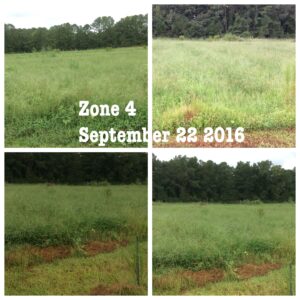
The photos below show zone 4 plowed and the raised beds prior to planting of the cover crop in November 2016. Hurricane Mathew delayed work in the fields and following that drought conditions delayed cover crop planting.
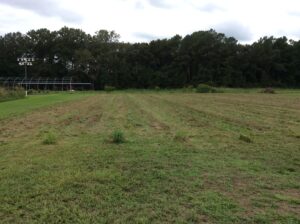
The photo shows the beds prepared for cover crop planting. Beds are tilled and raised beds pulled.
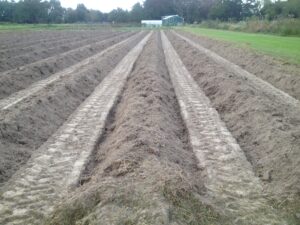
Video of Roller crimper used to cultipack cover crop seed. Novemeber 10 2016.
This video shows the rows already pulled up to raised beds and the roller crimper apparatus being used to cultipack the seed bed. (create soil contact with the newly planted seeds)
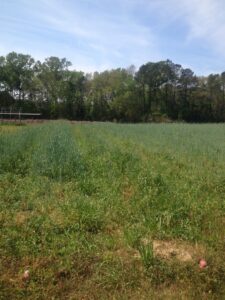
Video of March 29 2017 Crimping of Cover Crop
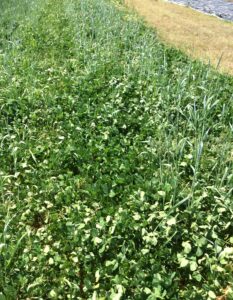
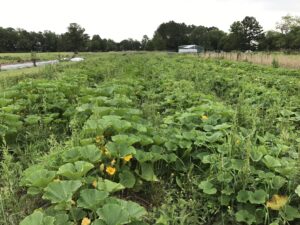
Prior to covering with tarp, zone was mowed with walk behind brush hog.
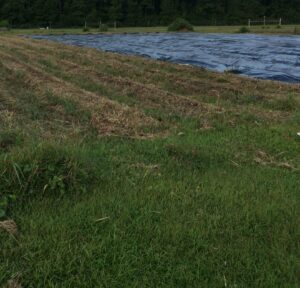
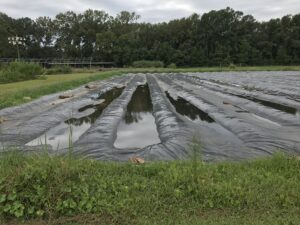
When the tarps were removed on December 17, 2017 the soil was in perfect condition for planting. The soil appeared as if it had been tilled with the fine rotary tiller. The soil color was dark and the tilth was excellent. The moisture was perfect for working the soil. We opted to reshape the beds with the bed shaper to assure that the beds were properly shaped for the crimper when it was used later the next spring.
Below is photo of the soil when the tarp was removed.
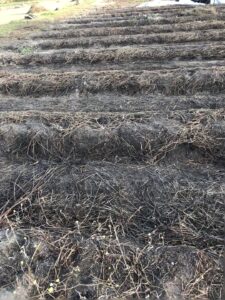
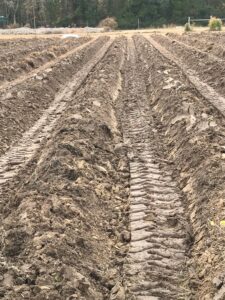
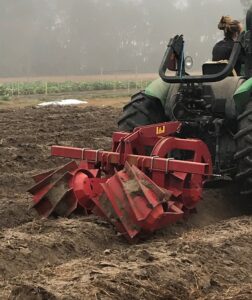
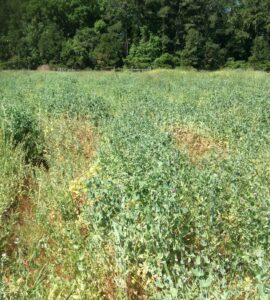
Following removal of the silage tarp, a cover crop of Austrian winter pea was planted on the entire area.
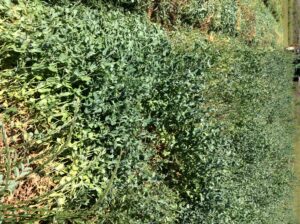
We chose to use a single cover crop type in order to assure that the cover would be terminated at the proper time. The mixed cover crop in the previous year did not terminate uniformly which caused us to re-crimp and some of the cover crop did not terminate fully.
The cover crop was crimped. Following are videos and photos of the cover crop being crimped and after the crimp. Because our plants needed another week to grow before transplanting, we let the crop die down and then re-covered with the tarp.
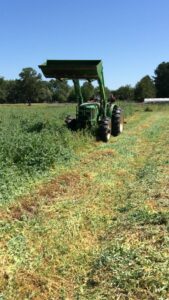
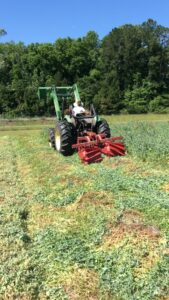
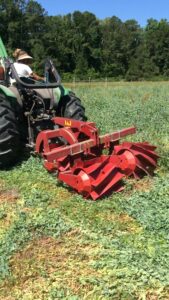
May 7 2018 Roller crimping Austrian winter pea. Short video.
Crimping Austrian winter pea cover crop. May 7 2018 demonstration. Long video.
Following the crimping the cover was fully terminated and allowed to dry. After 3 days the crimped cover crop was covered with silage tarp awaiting squash and cucumber transplants.
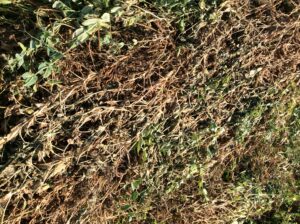
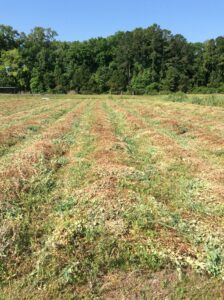
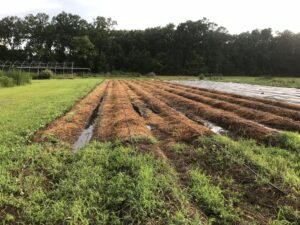
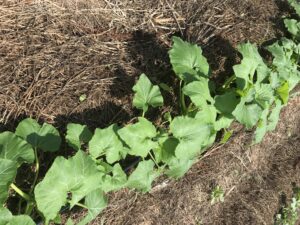
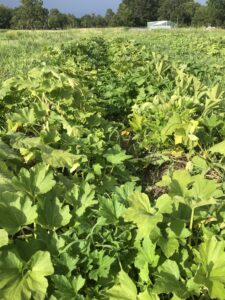
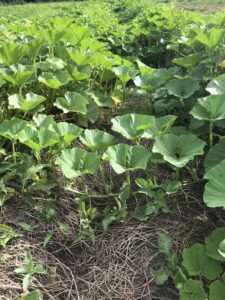
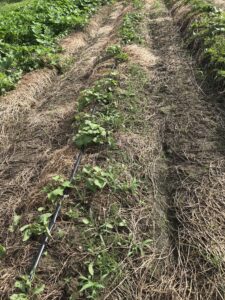
Educational & Outreach Activities
Participation Summary:
During the test period, several tours were conducted on the farm. Because the farm was conducting a soil study on behalf of Carolina Farm Stewards the farm hosted a tour focusing on soil health and the participants were given a report for the SARE Grant being conducted.
Gena Moore from Carolina Farm Stewards was also consulted and visited the study site 3 times. The group attending this workshop included farmers, consultants, agricultural educators, university staff, staff from organic certifying agencies and staff from agriculture groups such as Carolina Farm Stewards.
The attendees had never seen a roller crimper configured to fit raised beds.
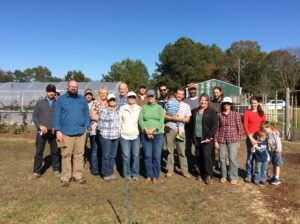
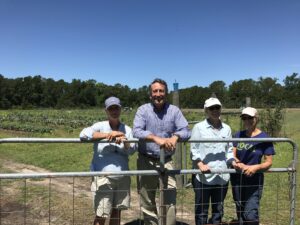
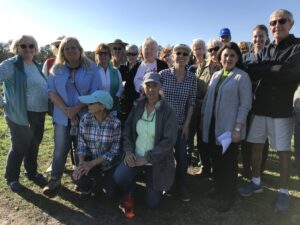
Beaufort County Master Gardeners visit Three Sisters Farm February 27 2018. Part of the tour explained to participants the roller crimper and the project.
Clint Leach, Assistant Commissioner of Agriculture for South Carolina arranged a visit from a congressional delegation to the farm on April 5, 2018. Sally McKay, Communications Director for the South Carolina Department of Agriculture led the group of policy staff who advise our state’s congressman and senators in Washington, DC on agriculture issues. They toured the farm and learned about our on-going SARE project.
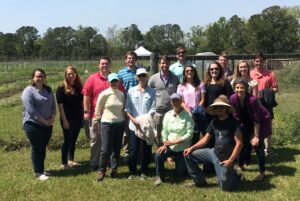
On May 7th, 2018 an on-farm demonstration was held. The demonstration showed the roller- crimper in action. Discussions with the collaborator extension agent led to utilizing the tarp to cover the crimped crop while waiting for the transplants to reach a suitable size for transplanting.
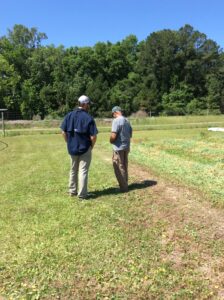
On July 10, 2018 The draft final report was presented to the Coastal Organic Growers group at their quarterly meeting. A number of farmers and other professionals were in attendance. Many of the farmers expressed interest in adopting the method of using the silage tarps and no till combination.
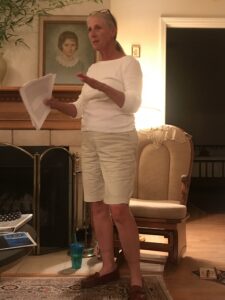
Learning Outcomes
Benefits of no till: No till definitely gave advantages to the soil health which was demonstrated by soil tests.
Benefits of cover cropping: Cover crops not only help the soil to maintain its integrity but also added much needed organic matter to the soil.
Benefits of ocultation: Covering with silage tarp greatly reduced the weed seed population on the fields. It was the only methods we have used on our farm to date to control nut sedge. Almost every weed was eliminated from the test area for a time. (not permanently, but a time sufficient to grow a crop)
Benefits of one species cover cropping when crimping a cover crop: One single species cover crop was used for the second series of cover cropping. The benefit of this was more complete termination of the cover crop when crimped and rolled.
Benefits of this method of cover crop-crimping-oculutation in series: The series of cover crop, roller crimping, ocultation was an excellent method for eliminating tillage in the test area. Without this specific series used, some type of tillage would have been required to create a seed bed for planting crops.
Weed control: Weeds were practically eliminated from the growing area for at least the time period for planting and harvesting the cash crops. Weed species that were impossible to control such as nut sedge and dollar weed were able to be controlled with this method.
Project Outcomes
The project had a tremendous affect on the operations on our farm. Our farm will implement this method in the future for almost all areas of cultivated crops.
There are several benefits that we were able to realize.
- From an economic standpoint, we will be able to lessen the amounts of fertilizers required for our crops. The Haney model test done on the test plot indicated that after the cover crop in the spring of 2018 was crimped, there was no need for any additional fertilizer. The Cation Exchange Capacity of the soil was raised to 11.8 where typically we would have only a range between 4 and 6 on most areas on the farm. The increase in CEC was as dramatic as adding high quality compost to our soil as demonstrated in another study on the farm that tested adding compost to the soil rather than fertilizers. (increased CEC to 10.4) Prior to the project, CEC on the farm range from 4 to 6.
- Another economic gain was the lessened need for hand weeding. As an organic operation, we do not use any chemicals to kill weeds. Hand weeding is a tiresome and time consuming task on farms and having an entire crop with no weeding required was a huge savings in labor cost. We would estimate that to hand weed one row it would take a worker about 4 hours. For the 21 rows, this is a savings of 84 man hours for one pass of the field. Normally several weeding passes are required (3 in most cases). This translates to a savings of 252 man hours. Additionally, finding labor to do these tasks is difficult as well. While labor costs will vary in different areas of the country, this would mean a savings from 4 to 6 thousand dollars.
- The environmental advantages for this method include less runoff from our field. When the field is covered with the tarp, there is no runoff of soil and nutrients which would ultimately end up in rivers and streams.
- The method used will lessen our labor costs thus increases the sustainability of the farm on an economic level. Saving our soil reserves also increases the sustainability of the farm itself.
- The social benefits of this method include the work savings for the farmer. Less work for a farmer means less stress and additional time to spend on other needs of the farm and the possibility of having time for other activities away from farm work.
One of the greatest challenges to this project was the timing of the cover crop and timing of the ocultation. Our farm would have benefited from an increase of time of ocultation but in order to plant crops at the proper time in the season the tarp would have to be removed earlier than we would have liked. There must be very careful timing in order for the cover crop to be terminated and the cash crop to be planted. These two events do not always ideally coincide. For example, the ideal time to plant our squash crop would be mid March, but that is too early to crimp the cover crop. Likewise a summer cover crop would ideally be terminated in September, but fall crops in our area need to be planted in late August.
Another modification to the process the farm will implement is to use tarps that are less than 40 feet wide. We are limited to using tarps at least 150 feet long because of the configuration of the beds on the farm, but tarps around 25 feet wide will be easier to manage by workers and also allow more flexibility in plantings. For example, occultation could occur in multiple sections simultaneously.